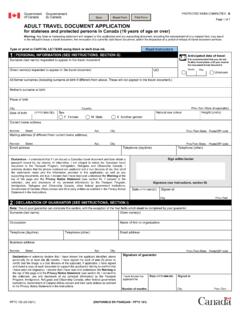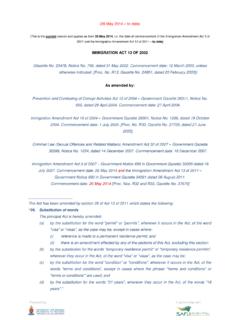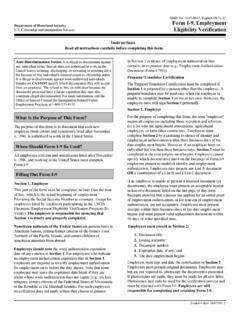Transcription of An Introduction to International Protection - UNHCR
1 An Introduction to International Protection Protecting persons of concern to UNHCR . Self-study module 1. 1 August 2005. Note This document has been produced by the Department of International Protection , Office of the United Nations High Commissioner for refugees . The content of this document may be shared, reproduced or photocopied without prior permission of UNHCR . Where material is used or quoted elsewhere an acknowledgement should be made to UNHCR as the source of information. Office of the United Nations High Commissioner for refugees Case Postale 2500. CH-1211 Geneva 2. Switzerland Fax: +41 22 739 7354. email: Website: i Contents An Introduction to International Protection Overview .. 1. Purpose .. 1. 1. Chapter 1. The development of and responsibility for International 3. Historical overview .. 5. The League of 5. The impact of the Second World War .. 6. Establishment of UNHCR .. 7. Towards a universal refugee concept: The 1951 9.
2 Current 10. Responsibility for International 12. 12. UNHCR .. 12. Persons in need of International Protection .. 13. refugees and asylum-seekers .. 13. Returnees .. 13. Stateless 14. Internally displaced persons (IDPs) .. 14. Working in 14. 14. United Nations bodies .. 15. Non-governmental organizations .. 15. Other organizations .. 16. refugees and other persons of concern to 16. 17. Additional 18. 19. Answer key to Chapter 1 exercises .. 21. Chapter 2. The legal framework for International Protection and its 23. Legal 25. International refugee 26. Universal 26. The 1951 Convention relating to the Status of refugees ..26. The 1967 Protocol relating to the Status of refugees ..27. Regional treaties .. 27. The 1969 OAU Convention Governing the Specific Aspects of Refugee Problems in European Union ii Contents Customary International law .. 28. Judicial decisions and academic 29. Soft law 29. International human rights law.
3 30. Universal instruments .. 32. Regional treaties .. 33. Customary International law .. 33. Human rights 34. Universal institutions ..34. Regional institutions ..35. International humanitarian law .. 36. International criminal law .. 37. United Nations Security Council resolutions .. 38. Implementation of the 1951 Convention / 1967 Protocol at the national level .. 39. Developing policy and practice .. 40. 42. Additional 43. 44. Answer key to Chapter 2 exercises .. 49. Chapter 3. The refugee definition .. 53. Refugee definitions in International instruments and national legislation .. 55. 1951 Convention .. 55. Inclusion Exclusion clauses ..58. Cessation clauses ..59. OAU Refugee 60. Cartagena Declaration .. 61. UNHCR 's International Protection mandate for refugees .. 61. National 61. Who determines whether a person falls within the definition of a refugee? 62. Common questions that arise in relation to the refugee definition in the 1951 Convention.
4 63. 65. Additional 67. 68. Answer key to Chapter 3 exercises .. 75. Chapter 4. Other persons of concern to UNHCR .. 81. Returnees .. 83. Legal framework .. 83. UNHCR 's 83. Stateless persons .. 84. Legal framework .. 85. UNHCR 's 86. iii Internally displaced persons .. 86. Legal framework .. 87. Inter-agency cooperation .. 88. UNHCR 's 88. Other 89. 90. Additional 91. 92. Answer key to Chapter 4 exercises .. 97. Chapter 5. The cycle of displacement .. 101. Part I: Flight and access to asylum .. 101. Why and how do refugees flee?.. 103. Admission into a country of asylum .. 104. Reception of asylum-seekers .. 105. Access to procedures for determining refugee 108. Individualized determination procedures .. 109. Group determination 112. Temporary Protection .. 112. 113. Additional 114. 115. Answer key to Chapter 5 exercises .. 118. Chapter 6. The cycle of displacement .. 119. Part II: Standards of treatment .. 119. Standards of 121.
5 Special Protection 124. Protection methodologies .. 126. Secondary 127. 128. Additional 129. 130. Answer key to Chapter 6 exercises .. 132. Chapter 7. The cycle of displacement .. 135. Part III: Timely and durable solutions .. 135. Overview .. 137. Voluntary repatriation .. 138. Local integration .. 141. Resettlement .. 143. 145. Additional 146. 147. Answer key to Chapter 7 exercises .. 150. 153. 1. An Introduction to International Protection Protecting persons of concern to UNHCR . Overview States have the primary responsibility for protecting refugees . The Office of the United Nations High Commissioner for refugees ( UNHCR ) works to ensure that governments take all actions necessary to protect refugees , asylum-seekers and other persons of concern who are on their territory or who are seeking admission to their territory. UNHCR , the sole International organization mandated to protect refugees globally, also strives to secure durable solutions for refugees so they can resume their normal lives.
6 Purpose This manual aims to: Foster a common understanding of International Protection among all UNHCR staff;. Familiarize UNHCR partners, whether governmental, inter- governmental or non-governmental, with the basic principles of International Protection ;. Contribute to the realization of the goals of the Agenda for Protection , which is an initiative between States, NGOs, IGOs and UNHCR , that seeks to enhance the Protection of refugees worldwide. Contents Each of the seven chapters of this manual contains information on one of the main aspects of International Protection : The development of and responsibility for International Protection ;. The legal framework for International Protection and its implementation;. The refugee definition;. Other persons of concern to UNHCR ;. Flight and access to asylum;. Standards of treatment;. Timely and durable solutions. 2 Overview Each chapter begins with a set of key learning objectives and ends with a summary, which can also be used in overhead presentations for training.
7 A list of additional reading material is provided at the close of each chapter, and a glossary of key terms is included at the end of the manual. In addition, there are exercises for independent study. Answers to the exercises, most of which can be found in the text, are provided on separate pages at the end of each chapter. The language used in this manual is intended to be non-legalistic and non-technical. Information on additional training materials and programmes can be obtained from UNHCR 's Department of International Protection in Geneva. 3. Chapter 1. The development of and responsibility for International Protection Key objectives Understand the history of International action in support of refugees , including the adoption of the 1951 Convention relating to the Status of refugees and the establishment of UNHCR . Be aware of current challenges impeding the provision of Protection for refugees . Identify the various actors responsible for International Protection and the importance of working in partnership with them.
8 An Introduction to International Protection 5. This chapter outlines the development of International Protection for refugees from its origins under the League of Nations, through the creation of UNHCR , to the present. It highlights current challenges to providing International Protection and examines the responsibilities of States and of UNHCR for ensuring that International Protection is delivered and durable solutions are found. The chapter also describes some of the other main actors involved in Protection activities. Historical overview Throughout history, people in every corner of the world have been forced to flee the countries of their birth in search of safety from persecution, political violence and/or armed conflict. But it was only at the beginning of the twentieth century that States recognized that protecting refugees required coordinated global action. The League of Nations In the 1920s and 1930s, the League of Nations, the first global body for inter-State cooperation and the forerunner of the United Nations launched a number of unprecedented initiatives aimed at helping refugees in Europe: 1921: Office of the High Commissioner for Russian refugees This Office was established in the aftermath of the First World War.
9 Initially, the task of the High Commissioner, Dr. Fridtjof Nansen, was to support people who had become refugees in the wake of the Russian revolution. He concentrated his efforts on clarifying their legal status in host countries by providing them with identity and travel documents. In addition, he sought to secure employment opportunities and to devise repatriation arrangements for them. Later on, Nansen was given responsibility for delivering aid to people displaced following the collapse of the Ottoman empire and for arranging their permanent settlement in countries other than those initially providing asylum. After Nansen's death in 1930, the International Nansen Office for refugees continued his work. This Office was replaced in 1938 by the appointment of a High Commissioner for refugees . 1933: High Commissioner for refugees coming from Germany As refugees began fleeing Hitler's Germany, the League of Nations appointed James McDonald as High Commissioner for refugees coming from Germany.
10 With immigration restrictions in force around the world, McDonald worked to find permanent homes for these refugees . In two years, he resettled over 80,000 refugees , mainly to Palestine. But in 1935, McDonald resigned in protest at the League of Nations' refusal to take stronger action on behalf of 6 The development of and responsibility for International Protection the Jews in Germany, where the newly adopted Nuremberg laws deprived them of citizenship and other fundamental rights. The position of High Commissioner for refugees coming from Germany was superseded in 1938 by that of the newly created High Commissioner for refugees . 1938: High Commissioner for refugees and Intergovernmental Committee on refugees As described above, the High Commissioner's office was an amalgamation of the International Nansen Office and the High Commissioner for refugees coming from Germany. Its role was very limited and ended in 1946. In the same year, an Intergovernmental Committee was convened.















